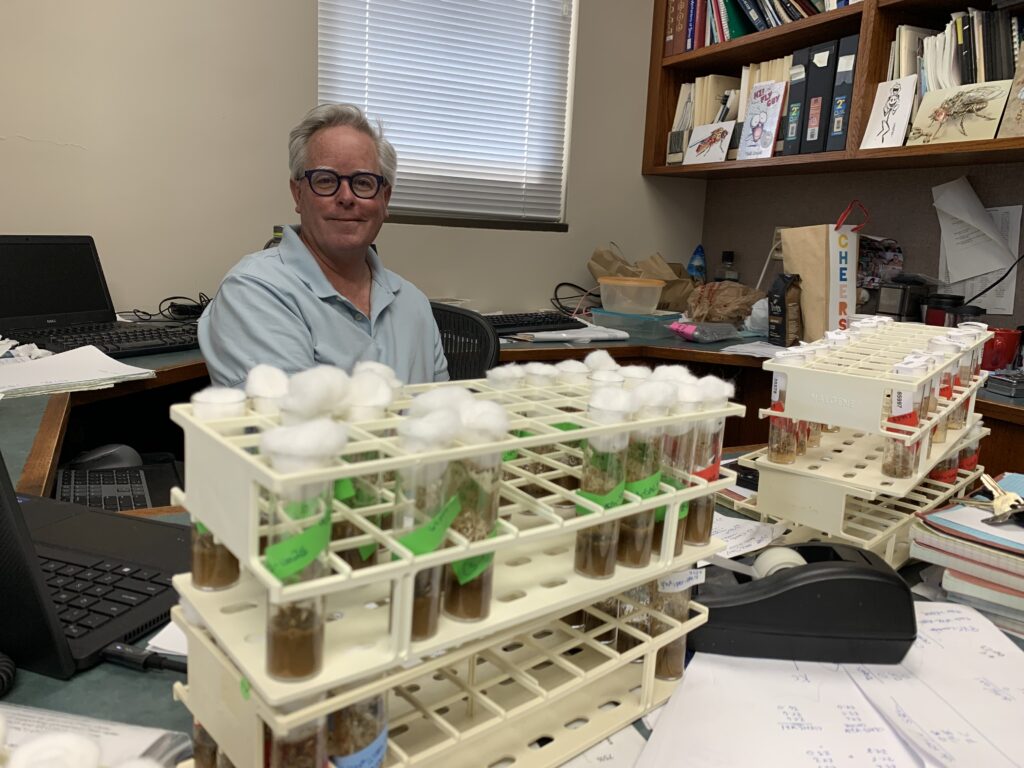For years, scientists have appreciated the tight link between sleep and temperature regulation. In fact, the very same neurons are responsible for both these essential functions. In 1997, Paul Shaw, then a PhD student in Allan Rechtschaffen’s lab at the University of Chicago, discovered that sleep deprivation could alter thermoregulation in rats: when kept awake, the animals preferred warmer temps. The finding confirmed what had been reported in people, that a loss of sleep makes them feel colder. In a new study published in Frontiers in Neuroscience, Shaw, Professor of Neuroscience at Washington University School of Medicine, and his lab extended this line of research to reveal that it’s not just sleep loss that affects temperature preference, but also sleep fragmentation and “social jetlag,” a temporary shift in the timing of sleep.
The experiments were conducted in fruit flies, illustrating that sleep’s effect on temperature preference is conserved from insects to primates. The most lasting changes in flies’ desire for warmth resulted from social jetlag—a model of people’s common weekend pattern of staying up late and sleeping in.
“That surprised the crap out of me,” Shaw said. “Their total amount of sleep doesn’t change, just when they get it. So, sleep deprivation isn’t as bad as social jetlag. How is that possible?” The answer to that question might be buzzing right before his eyes.
Simple experiment, complicated result
Paul Shaw’s desk reflects the inventor-neuroscientist who sits behind it. Scattered before him are a tape measure, academic papers, coffeemaker, paintings of fruit flies, and hundreds of genetically modified Drosophila melanogaster, flitting around inside racks of clear tubes. The insects have various genes knocked out, in hopes of identifying those responsible for social jet lag’s surprisingly long effect on temperature preference. They are the latest development in a project that began with a very simple question: can sleep deprivation change temperature preference in flies?
In 2014, the task of answering that question fell to Tanner Roach, a WashU undergraduate in the Shaw Lab at the time. Roach devised a contraption to track flies’ temperature preference using a box positioned on a hot plate at one end and a container of ice at the other. By greasing the walls and ceiling of the box, Roach forced the flies to walk on the metal floor and choose where to rest along the floor’s temperature gradient. “It wasn’t a super complicated apparatus to make, which is why it’s so great,” said Roach. “If another lab wanted to do a temperature preference experiment, they could replicate it.”
Sleep-deprived flies were subjected to the sleep-nullifying apparatus, or SNAP, a container Shaw invented which, as its name indicates, jerks violently at regular intervals to keep the animals within awake. Flies that went through the SNAP treatment every two minutes overnight chose warmer parts of the temperature-preference container than when they were fully rested. The same was true when flies experienced sleep fragmentation—being snapped awake every 15 minutes to prevent deep sleep. They too preferred warmer areas of the container.
I’ve tested it many times, with many technicians, and in many different ways, and as far as I can tell, sleep fragmentation does not affect learning. But it does reliably and reproducibly and robustly change temperature preference.
Paul Shaw, PhD
To figure out the mechanism of this response, the researchers knocked down one of two circadian components in the fly brain, the period or Pigment dispersing factor receptor (Pdfr) genes. Period knockouts displayed a preference for warmer temps after sleep loss or disruption, while flies with impeded Pdfr remained unchanged, pointing to Pdfr as important in regulating this response.
After Roach moved on to start an MD/PhD program at the University of Illinois at Chicago, Melanie Ford, a technician in the Shaw lab, began the routine process of replicating Roach’s experiments and confirming his findings. She also added a new set of studies on social jetlag, forcing flies to shift their sleep three hours later over the weekend. These flies also displayed a preference for warmer temperatures. But this effect lasted days longer than the shift that occurred after sleep fragmentation or sleep deprivation. “I was pretty surprised,” said Ford. “Sleep deprivation does seem like a more severe experience and they’re able to recover from that more quickly.”
Ford added that social jetlag can have untoward consequences on people, and little is known about the molecular pathways involved in responding to shifted sleep schedules. She is now turning her attention to screening the different fly genotypes to see if any affect social jetlag.
Social jetlag also resulted in impaired learning and memory among the flies, while sleep fragmentation had no effect. Shaw said the latter finding is one he’s found hard to accept. “I’ve tested it many times, with many technicians, and in many different ways, and as far as I can tell, sleep fragmentation does not affect learning. But it does reliably and reproducibly and robustly change temperature preference.”
Shaw said he’s not certain why flies seek out warmer temperatures when their sleep is disrupted, but it’s likely an adaptation. What is certain is that the neurons his team are studying regulate sleep and regulate temperature preference. “The fact that they do both things imply a conserved function of sleep and thermoregulation,” said Shaw. Given the evolutionary conservation of sleep’s relationship to thermoregulation, the function of the temperature-preference response, and indeed of sleep itself, may be found in the little flies on Shaw’s desk.
